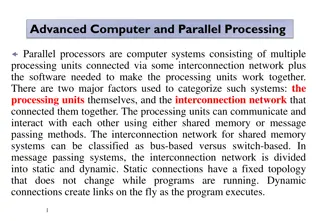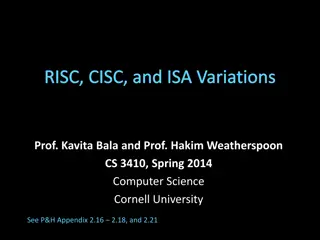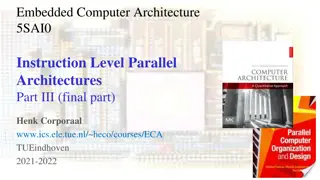Understanding Computer Architecture: Superscalar Pipelines
Explore the concept of Superscalar Pipelines in computer architecture, featuring in-order execution, instruction-level parallelism, hardware issues, and more. Discover the limitations of scalar pipelines and the potential for parallel execution. Delve into the required checking for executing multiple instructions simultaneously, highlighting the complexity involved in achieving efficient parallel processing.
- Computer Architecture
- Superscalar Pipelines
- Instruction-Level Parallelism
- Parallel Execution
- Hardware Issues
Download Presentation

Please find below an Image/Link to download the presentation.
The content on the website is provided AS IS for your information and personal use only. It may not be sold, licensed, or shared on other websites without obtaining consent from the author. Download presentation by click this link. If you encounter any issues during the download, it is possible that the publisher has removed the file from their server.
E N D
Presentation Transcript
CSU33014: Computer Architecture Superscalar Pipelines Slides developed by Joe Devietti, Milo Martin & Amir Roth at U. Penn with sources that included University of Wisconsin slides by Mark Hill, Guri Sohi, Jim Smith, and David Wood 1
This Unit: (In-Order) Superscalar Pipelines App App App Idea of instruction-level parallelism System software Superscalar hardware issues Bypassing and register file Stall logic Fetch Mem I/O CPU 2
Scalar Pipeline regfile I$ D$ B P So far we have looked at scalar pipelines One instruction per stage With control speculation, bypassing, etc. Performance limit is CPI = IPC = 1 CPI cycles per instruction IPC instructions per cycle Limit is never even achieved (hazards) Diminishing returns from deeper pipelines (hazards + overhead) 3
An Opportunity But consider: ADD r1, r2 -> r3 ADD r4, r5 -> r6 Why not execute them at the same time? (We can!) What about: ADD r1, r2 -> r3 ADD r4, r3 -> r6 In this case, dependences prevent parallel execution What about three instructions at a time? Or four instructions at a time? 4
What Checking Is Required? For two instructions: 2 checks ADD src11, src21 -> dest1 ADD src12, src22 -> dest2 (2 checks) For three instructions: 6 checks ADD src11, src21 -> dest1 ADD src12, src22 -> dest2 (2 checks) ADD src13, src23 -> dest3 (4 checks) For four instructions: 12 checks ADD src11, src21 -> dest1 ADD src12, src22 -> dest2 (2 checks) ADD src13, src23 -> dest3 (4 checks) ADD src14, src24 -> dest4 (6 checks) Plus checking for load-to-use stalls from prior n loads 5
What Checking Is Required? For two instructions: 2 checks ADD src11, src21 -> dest1 ADD src12, src22 -> dest2 (2 checks) For three instructions: 6 checks ADD src11, src21 -> dest1 ADD src12, src22 -> dest2 (2 checks) ADD src13, src23 -> dest3 (4 checks) For four instructions: 12 checks ADD src11, src21 -> dest1 ADD src12, src22 -> dest2 (2 checks) ADD src13, src23 -> dest3 (4 checks) ADD src14, src24 -> dest4 (6 checks) Plus checking for load-to-use stalls from prior n loads 6
How do we build such superscalar hardware? 7
Multiple-Issue or Superscalar Pipeline regfile I$ D$ B P Overcome this limit using multiple issue Also called superscalar Two instructions per stage at once, or three, or four, or eight Instruction-Level Parallelism (ILP) [Fisher, IEEE TC 81] Today, typically 4-wide (Intel Core i7, AMD Opteron) Some more (Power5 is 5-issue; Itanium is 6-issue) Some less (dual-issue is common for simple cores) 8
A Typical Dual-Issue Pipeline (1 of 2) regfile I$ D$ B P Fetch an entire 16B or 32B cache block 4 to 8 instructions (assuming 4-byte average instruction length) Predict a single branch per cycle Parallel decode Need to check for conflicting instructions Is output register of I1 is an input register to I2? Other stalls, too (for example, load-use delay) 9
A Typical Dual-Issue Pipeline (2 of 2) regfile I$ D$ B P Multi-ported register file Larger area, latency, power, cost, complexity Multiple execution units Simple adders are easy, but bypass paths are expensive Memory unit Single load per cycle (stall at decode) probably okay for dual issue Alternative: add a read port to data cache Larger area, latency, power, cost, complexity 10
Superscalar Implementation Challenges 11
Superscalar Challenges - Front End Superscalar instruction fetch Modest: fetch multiple instructions per cycle Aggressive: buffer instructions and/or predict multiple branches Superscalar instruction decode Replicate decoders Superscalar instruction issue Determine when instructions can proceed in parallel More complex stall logic - O(N2) for N-wide machine Not all combinations of types of instructions possible Superscalar register read Port for each register read (4-wide superscalar 8 read ports ) Each port needs its own set of address and data wires Latency & area #ports2 12
Superscalar Challenges - Back End Superscalar instruction execution Replicate arithmetic units (but not all, say, integer divider) Perhaps multiple cache ports (slower access, higher energy) Only for 4-wide or larger (why? only ~25% are load/store insn) Superscalar register bypass paths More possible sources for data values O(N2)for N-wide machine Superscalar instruction register writeback One write port per instruction that writes a register Example, 4-wide superscalar 4 write ports Fundamental challenge: Amount of ILP (instruction-level parallelism) in the program 13
Superscalar Register Bypass Flow of data between instructions Consider the code r1 = r3 * r4; r7 = r1 + r2; The second instruction consumes a value computed by the first Simple solution First instruction writes its result to r1 Second instruction reads value from r1 But the write and read take time The write-back pipeline stage normally happens at least one cycle later than the execute Register read normally happens at least one cycle earlier than execute Potential for delay of one or more cycles 14
Superscalar Register Bypass Flow of data between instructions Consider the code r1 = r3 * r4; r7 = r1 + r2; The second instruction consumes a value computed by the first Register Bypassing Hardware mechanism to allow data to flow directly from the output of one instruction to the input of another The result of the first instruction is written to register r1 But at the same time a second copy of the result is piped directly to the arithmetic unit that consumes the value Requires a hardware interconnection network between the outputs of functional units (such as adders, multipliers) and the inputs of other functional units 15
Not All N2 Created Equal N2 bypass vs. N2 stall logic & dependence cross-check Which is the bigger problem? N2bypass by far 64- bit quantities (vs. 5-bit register indices) Multiple levels (MX, WX) of bypass (vs. 1 level of stall logic) Must fit in one clock period with ALU (vs. not) Dependence cross-check not even 2nd biggest N2 problem Register file is also an N2 problem (think latency where N is #ports) And also more serious than cross-check 16
Superscalar Register Bypass N2 bypass network (N+1)-input muxes at each ALU input N2 point-to-point connections Routing lengthens wires Heavy capacitive load versus And this is just one bypass stage! Even more for deeper pipelines One of the big problems of superscalar Why? On the critical path of single-cycle bypass & execute loop 17
Mitigating N2 Bypass & Register File Clustering: mitigates N2 bypass Group ALUs into K clusters Full bypassing within a cluster Limited bypassing between clusters With 1 or 2 cycle delay Can hurt IPC, but faster clock (N/K) + 1 inputs at each mux (N/K)2 bypass paths in each cluster Steering: key to performance Steer dependent insns to same cluster Cluster register file, too Replicate a register file per cluster All register writes update all replicas Fewer read ports; only for cluster 18
Mitigating N2 RegFile: Clustering++ cluster 0 RF0 RF1 cluster 1 DM Clustering: split N-wide execution pipeline into K clusters With centralized register file, 2N read ports and N write ports Clustered register file: extend clustering to register file Replicate the register file (one replica per cluster) Register file supplies register operands to just its cluster All register writes go to all register files (keep them in sync) Advantage: fewer read ports per register! K register files, each with 2N/K read ports and N write ports 19
Another Challenge: Superscalar Fetch What is involved in fetching multiple instructions per cycle? In same cache block? no problem 64-byte cache block is 16 instructions (~4 bytes per instruction) Favors larger block size (independent of hit rate) What if next instruction is last instruction in a block? Fetch only one instruction that cycle Or, some processors may allow fetching from 2 consecutive blocks What about taken branches? How many instructions can be fetched on average? Average number of instructions per taken branch? Assume: 20% branches, 50% taken ~10 instructions Consider a 5-instruction loop with a 4-issue processor Without smarter fetch, ILP is limited to 2.5 (not 4, which is bad) 20
Increasing Superscalar Fetch Rate regfile I$ B P insn queue D$ also loop stream detector Option #1: over-fetch and buffer Add a queue between fetch and decode (18 entries in Intel Core2) Compensates for cycles that fetch less than maximum instructions decouples the front end (fetch) from the back end (execute) Option #2: loop stream detector (Core 2, Core i7) Put entire loop body into a small cache Core2: 18 macro-ops, up to four taken branches Core i7: 28 micro-ops (avoids re-decoding macro-ops!) Any branch mis-prediction requires normal re-fetch Other options: next-next-block prediction, trace cache 21
Multiple-Issue Implementations Statically-scheduled (in-order) superscalar What we ve talked about thus far + Executes unmodified sequential programs Hardware must figure out what can be done in parallel E.g., Pentium (2-wide), UltraSPARC (4-wide), Alpha 21164 (4-wide) Very Long Instruction Word (VLIW) - Compiler identifies independent instructions, new ISA + Hardware can be simple and perhaps lower power E.g., TransMeta Crusoe (4-wide) Dynamically-scheduled superscalar (next topic) Hardware extracts more ILP by on-the-fly reordering Core 2, Core i7 (4-wide), Alpha 21264 (4-wide) 22
Trends in Single-Processor Multiple Issue 486 Pentium PentiumII Pentium4 Itanium ItaniumII Core2 Year Width 1989 1 1993 2 1998 3 2001 3 2002 3 2004 6 2006 4 Issue width has saturated at 4-6 for high-performance cores Canceled Alpha 21464 was 8-way issue Not enough ILP to justify going to wider issue Hardware or compiler scheduling needed to exploit 4-6 effectively More on this in the next unit For high-performance per watt cores (say, smart phones) Typically 2-wide superscalar (but increasing each generation) 23


![❤Book⚡[PDF]✔ The Apollo Guidance Computer: Architecture and Operation (Springer](/thumb/21611/book-pdf-the-apollo-guidance-computer-architecture-and-operation-springer.jpg)




















